U.S.-allied fighters in Syria have begun the arduous work of documenting the devastation in Raqqa, the former Islamic State “capital” that the jihadist group has left in near-total destruction.
The Syrian Democratic Forces (SDF), a coalition of mostly Kurdish anti-ISIS fighters, announced the liberation of Raqqa last week following their capture of the city’s hospital, which the Islamic State had turned into a command center. The SDF has barred most civilians from entering the city due to the extreme deterioration of its infrastructure and the pervasive presence of landmines, booby traps, and explosives littered throughout the city.
The United States officially declared Raqqa liberated from the Islamic State later in the week, with President Donald Trump declaring on Saturday a “critical breakthrough in our worldwide campaign to defeat ISIS and its wicked ideology”:
.@POTUS announces defeat of #ISIS in #Raqqah. We stand prepared to assist w/ urgent humanitarian needs, security & restoring infrastructure. pic.twitter.com/NZR4tL6JSq
— Heather Nauert (@statedeptspox) October 21, 2017
Shortly before the Trump announcement, Secretary of State Rex Tillerson issued a statement declaring “the beginning of a new phase in the Syrian conflict,” one focused on reconstruction rather than battle.
U.S. coalition against ISIS chief envoy Brett McGurk has publicly estimated that jihadists left 150 bombs surrounding Raqqa’s water treatment plant alone, suggesting a much larger number of hidden explosives placed throughout the city. SDF spokesman Talal Sillo told reporters last week that the group would not allow most civilians to return to their daily lives until bomb clearing operations were complete.
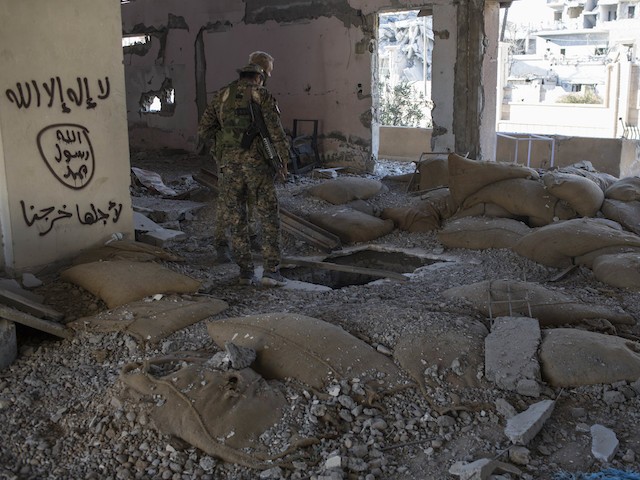
Members of the Syrian Democratic Forces SDF check for IEDs at the stadium where IS fighter’s last stand in the city of Raqqa before most fighters hand in and left the city Syria, October 18, 2017. (AP Photo/Asmaa Waguih)
The SDF did, however, allow a small number of civilians to enter the city for a small celebratory ceremony on Friday in Raqqa’s stadium, the location of the last bit of fighting before the SDF announced the liberation of the city. Those civilians expressed shock and dismay to the Agence France-Presse (AFP), with some stating they may not return even when the city is rebuilt.
“This was once the most beautiful city, my God,” one woman gasped.
“I wasn’t expecting the destruction to be this bad. It’s unreal—there are no buildings left, no infrastructure, no signs of life whatsoever,” attorney Fadila Hamad al-Khalil said.
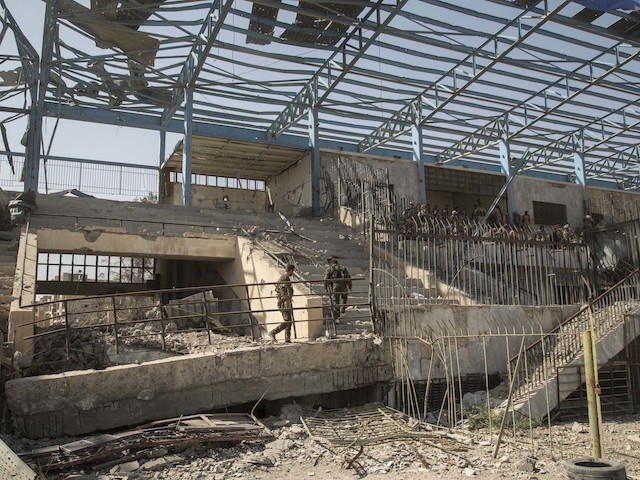
Members of the U.S.-backed Syrian Democratic Forces (SDF) walk in a stadium that was the site of Islamic State fighters’ last stand in the city of Raqqa, Syria, Friday, Oct. 20, 2017. (AP Photo/Asmaa Waguih)
The AFP notes that, while some of the buildings still have semi-visible signs for businesses, “most of Raqqa has been left in unrecognizable ruin.”

A traffic roundabout in the city of Raqqa, Syria, Wednesday, Oct. 18, 2017. U.S.-backed fighters were removing landmines and clearing roads in the northern city a day after commanders said they had driven the Islamic State group from its de facto capital. (AP Photo)

This Thursday, Oct. 19, 2017 frame grab made from drone video shows damaged buildings in Raqqa, Syria, two days after Syrian Democratic Forces said that military operations to oust the Islamic State group have ended and that their fighters have taken full control of the city. (AP Photo/ Gabriel Chaim)

A member of the Syrian Democratic Forces (SDF), backed by US special forces, talks on the radio near Raqqa’s stadium as they clear the last positions on the frontline on October 16, 2017, in the Islamic State (IS) group jihadists crumbling stronghold. (BULENT KILIC/AFP/Getty Images)
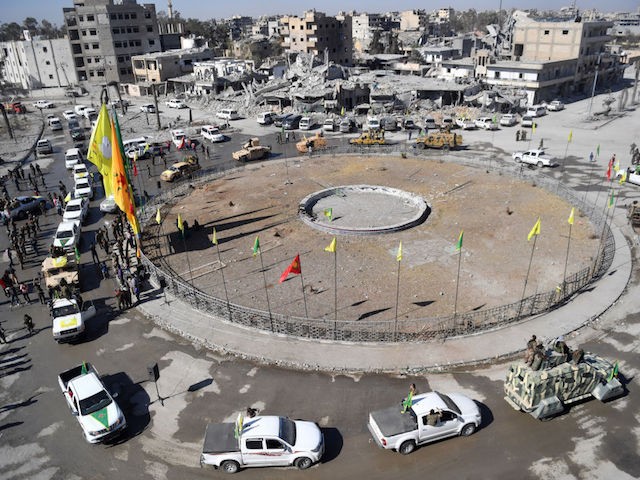
Female fighters of the Syrian Democratic Forces (SDF) gather during a celebration at the iconic Al-Naim square in Raqqa on October 19, 2017, after retaking the city from Islamic State (IS) group fighters. (BULENT KILIC/AFP/Getty Images)
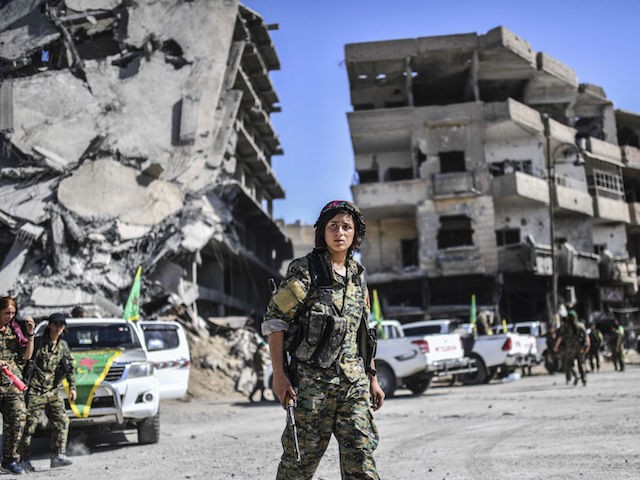
Kurdish female fighters of the Syrian Democratic Forces (SDF) gather during a celebration at the iconic Al-Naim square in Raqqa on October 19, 2017, after retaking the city from Islamic State (IS) group fighters. (BULENT KILIC/AFP/Getty Images)

A general view shows heavily damaged buildings in Raqqa on October 20, 2017, after a Kurdish-led force expelled the Islamic State group from the northern Syrian city. (BULENT KILIC/AFP/Getty Images)
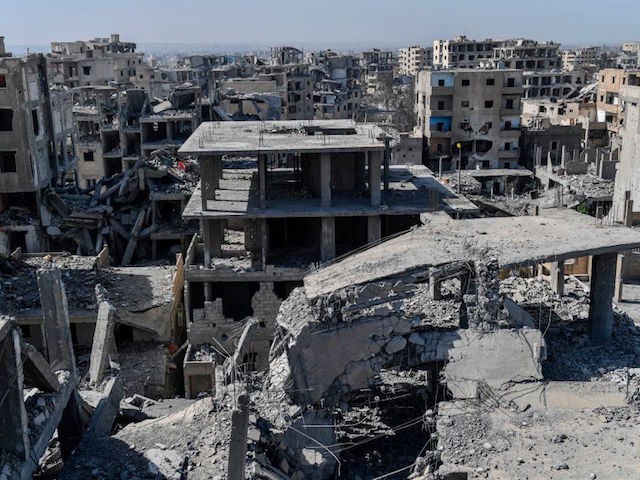
A picture taken on October 20, 2017, shows a general view of heavily damaged buildings in Raqqa, after a Kurdish-led force expelled Islamic State (IS) group fighters from the northern Syrian city, formerly their “capital”. (BULENT KILIC/AFP/Getty Images)

A picture taken on October 20, 2017, shows a general view of heavily damaged buildings in Raqqa, after a Kurdish-led force expelled Islamic State (IS) group fighters from the northern Syrian city, formerly their “capital.” (BULENT KILIC/AFP/Getty Images)
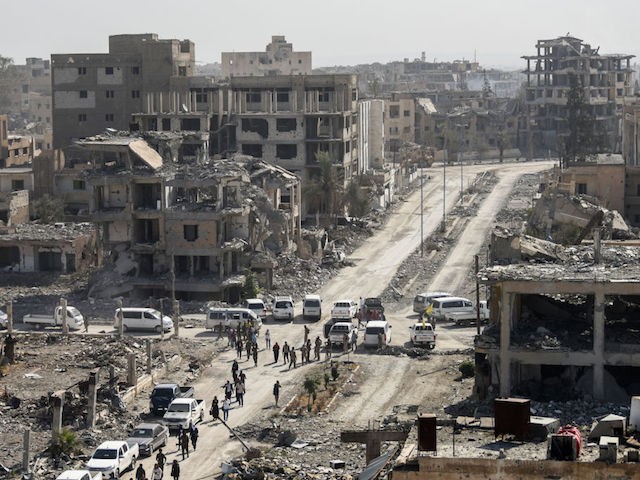
A picture taken on October 20, 2017, shows a general view of heavily damaged buildings in Raqqa, after a Kurdish-led force expelled Islamic State (IS) group fighters from the northern Syrian city, formerly their “capital.” (BULENT KILIC/AFP/Getty Images)

A picture shows heavily damaged buildings in Raqqa on October 21, 2017, after a Kurdish-led force expelled Islamic State (IS) group fighters from the northern Syrian city. (BULENT KILIC/AFP/Getty Images)
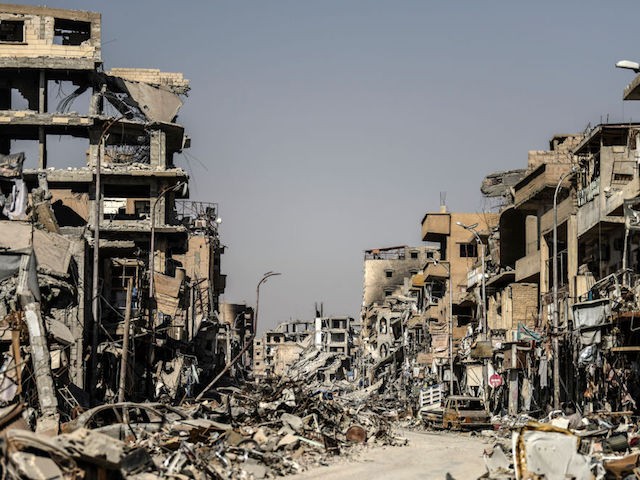
A picture taken on October 21, 2017, shows a general view of heavily damaged buildings in Raqqa, after a Kurdish-led force expelled the Islamic State group from the northern Syrian city. (BULENT KILIC/AFP/Getty Images)
The Islamic State captured Raqqa in 2014, when it still operated as the Islamic State of Iraq and Syria (ISIS), an offshoot of al-Qaeda. Shortly after their establishment in the city, the group’s leader, Abu Bakr al-Baghdadi, announced that the group had founded an Islamic State with its capital in Raqqa, and that he was the caliph of this new empire. Estimates regarding the scope of ISIS influence find that Baghdadi played “caliph” over land the size of the nation of Jordan and controlled $80 million in revenue in 2015.
American officials and fighters on the ground warn that the Islamic State still controls some pockets of resistance in Syria and Iraq, and maintain influence in nations like Libya and Afghanistan.
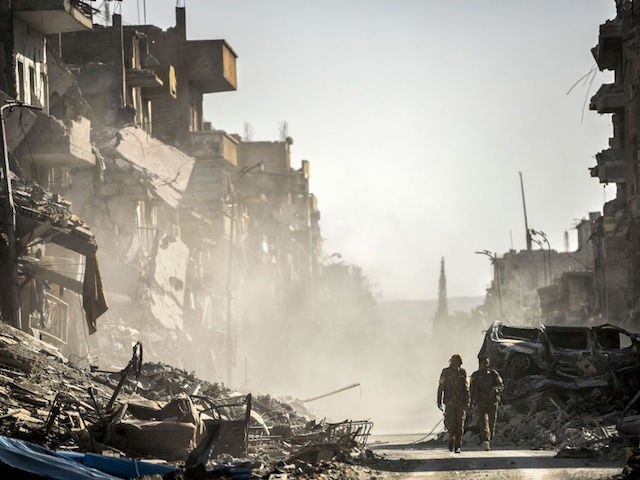
COMMENTS
Please let us know if you're having issues with commenting.